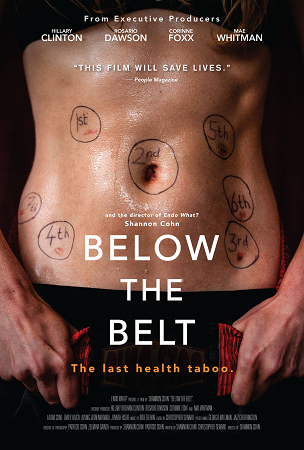
Below the Belt 2023
Distributed by Good Docs
Produced by Patricio Cohn and Shannon Cohn
Directed by Shannon Cohn
Streaming, 52 mins
General Adult
Public Health, Women’s Health
Date Entered: 04/03/2024
Reviewed by Lauren Stieglitz, Science Liaison Librarian, University of AlbertaBelow the Belt shines a light on the problems with our healthcare systems by sharing the experiences of four women with endometriosis, a common condition where tissue similar to uterine tissue grows outside of the uterus. It is often painful, causing inflammation and scar tissue in the pelvic region as well as infertility in some cases. Additionally, gender bias in healthcare and poorly informed doctors lead to significant delays in diagnosis and care. Below the Belt delves into the causes and effects of this health disparity in a thought-provoking and informative way.
Below the Belt primarily follows four women with endometriosis. It shows many facets to living with endometriosis, including difficulties getting diagnoses, the negative ways chronic pain has affected their lives and the harsh treatments they have received. These segments are a powerful way of showing how endometriosis effects patients. It is particularly moving to see how Kyung, a visual artist, depicts her pain through her art as she struggles with infertility and pregnancy loss. These women’s experiences also touch on the ways that endometriosis care is lacking; the documentary shows difficulty getting diagnoses, having to pay for expensive surgery out of pocket, and, in one case, show delays in care and treatment lead to worse outcomes for patients. These sections put a powerful human face to a very common issue.
The documentary balances these personal stories with testimonials and video clips of additional women’s experiences, headlines of news stories, and facts or statistics displayed as text. Additionally, some endometriosis specialists are included to provide an expert point of view. This gives a more complete picture of the many issues surrounding the diagnosis and treatment of endometriosis, marginalization of women’s health issues, and the advocacy work around endometriosis. Below the Belt shows a wide breadth of information on this complex topic, effectively balancing factual information and individual experiences.
The only downside to Below the Belt is that it solely presents the perspective of cis women. As endometriosis also affects a number of trans and non-binary people, it would have been good to acknowledge the experience of trans and non-binary people with endometriosis. Most of the language in the documentary refers exclusively to women, however, the title cards the documentary uses to share facts about endometriosis do use gender inclusive language. Those looking for a more inclusive discussion of healthcare challenges faced by uterus-havers should look elsewhere.
Below the Belt is a fantastic, moving documentary. It provides a well-rounded look into the complex issue of endometriosis, showing the human cost of gender bias in health care. Given how poorly endometriosis is diagnosed and how many health practitioners provide inadequate care for endometriosis patients, this would be a vital addition to any medical curriculum. It would also be great for women’s studies or gender studies courses.
Published and licensed under the Creative Commons Attribution 4.0 license. Anyone can use these reviews, so long as they comply with the terms of the license.